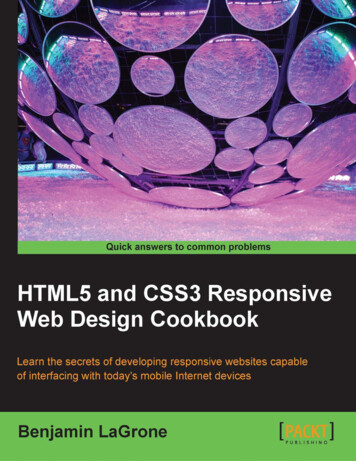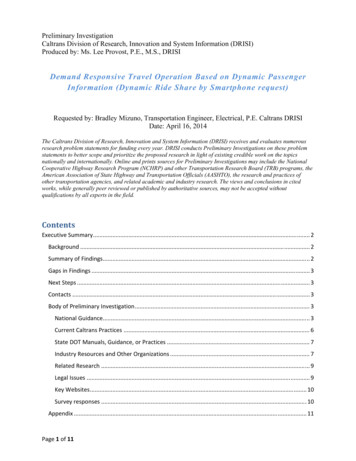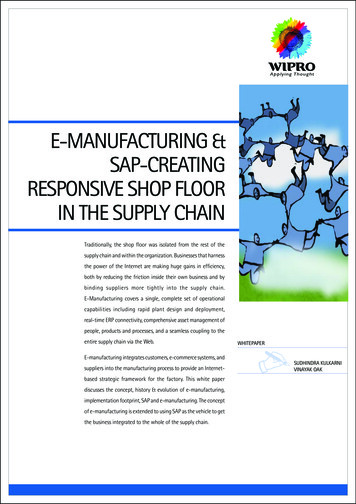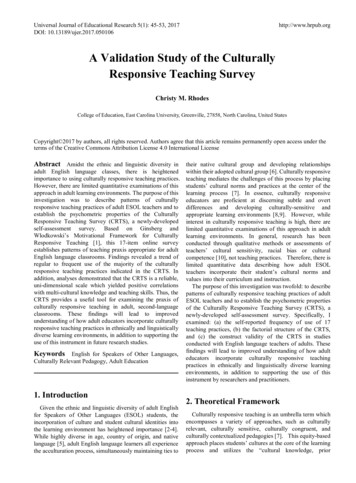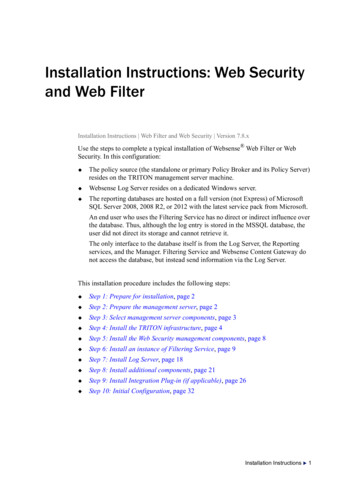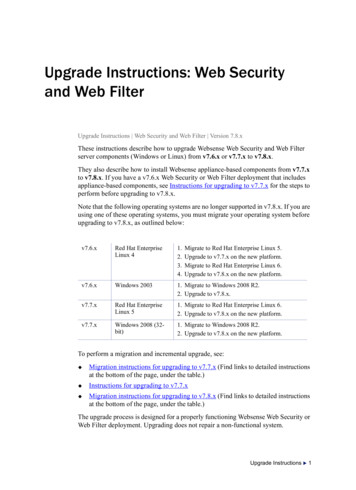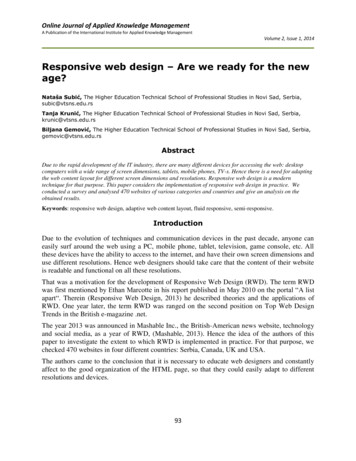
Transcription
Online Journal of Applied Knowledge ManagementA Publication of the International Institute for Applied Knowledge ManagementVolume 2, Issue 1, 2014Responsive web design – Are we ready for the newage?Nataša Subić, The Higher Education Technical School of Professional Studies in Novi Sad, Serbia,subic@vtsns.edu.rsTanja Krunić, The Higher Education Technical School of Professional Studies in Novi Sad, Serbia,krunic@vtsns.edu.rsBiljana Gemović, The Higher Education Technical School of Professional Studies in Novi Sad, Serbia,gemovic@vtsns.edu.rsAbstractDue to the rapid development of the IT industry, there are many different devices for accessing the web: desktopcomputers with a wide range of screen dimensions, tablets, mobile phones, TV-s. Hence there is a need for adaptingthe web content layout for different screen dimensions and resolutions. Responsive web design is a moderntechnique for that purpose. This paper considers the implementation of responsive web design in practice. Weconducted a survey and analysed 470 websites of various categories and countries and give an analysis on theobtained results.Keywords: responsive web design, adaptive web content layout, fluid responsive, semi-responsive.IntroductionDue to the evolution of techniques and communication devices in the past decade, anyone caneasily surf around the web using a PC, mobile phone, tablet, television, game console, etc. Allthese devices have the ability to access to the internet, and have their own screen dimensions anduse different resolutions. Hence web designers should take care that the content of their websiteis readable and functional on all these resolutions.That was a motivation for the development of Responsive Web Design (RWD). The term RWDwas first mentioned by Ethan Marcotte in his report published in May 2010 on the portal “A listapart“. Therein (Responsive Web Design, 2013) he described theories and the applications ofRWD. One year later, the term RWD was ranged on the second position on Top Web DesignTrends in the British e-magazine .net.The year 2013 was announced in Mashable Inc., the British-American news website, technologyand social media, as a year of RWD, (Mashable, 2013). Hence the idea of the authors of thispaper to investigate the extent to which RWD is implemented in practice. For that purpose, wechecked 470 websites in four different countries: Serbia, Canada, UK and USA.The authors came to the conclusion that it is necessary to educate web designers and constantlyaffect to the good organization of the HTML page, so that they could easily adapt to differentresolutions and devices.93
Online Journal of Applied Knowledge ManagementA Publication of the International Institute for Applied Knowledge ManagementVolume 2, Issue 1, 2014Responsive Web Design (RWD)The main idea of the basic principles of RWD and Rich Internet Applications (RIA) is Web forAll and Web on Everything, see (Karolić, 2013.). The essence of this idea is to enable access tothe web content for all existing media. As already stated in the Introduction, nowadays, there arevarious types of devices for accessing the Internet that have different screen dimensions. Butusers have similar needs when surfing around the web, regardless of the device they are using.For, example, getting information from websites created for wide screen computers, accessingthe web by mobile phone can be quite uncomfortable. Hence the need for adapting the layout ofthe web content for different screen dimensions and resolutions. On the other hand, creatingdifferent web pages for various devices is a hard work for web designers, and should also beavoided. Together with the development of the media industry (mobile phones, ePads, screens),techniques for adapting web content for different media are developing too. In this context,RWD appears to be a good solution.In the last four years, there is an increase for more than 45% of the use of mobile phones foraccessing the web. The estimated number of people accessing the web per mobile phone is about1.1 billion (Musti, Kashyap, 2013.). According to a prediction of the Ericsson company,(Vanguardngr, 2014), the number of mobile phone users will reach 9 billion in 2018. It isexpected that smart phones keep the leader position among other mobile devices.Overall, the content layout should be well adapted to the users' media. As we can conclude fromFig. 1, there is a wide range of screen dimensions and devices.Fig. 1. Content layout on different media (Musti, Kashyap, 2013.)It is not flexible and not profitable to conduct surveys about what devices users use for accessingyour website and adapting the website according to the results. The right solution for differentuser devices is creating a flexible, smart and adaptive website. In order to do so, one has to takeinto account different screen dimensions and resolutions and to adapt the content layoutaccordingly. This is a relatively new concept and requires a well organized HTML structure, assuch a structure can be flexible to different devices. Therefore, it is advisable to pay attention to(Developing responsive, 2013; Images Guide, 2013): The number of columns of the web page should be adaptive to the screen/windowdimensions94
Online Journal of Applied Knowledge ManagementA Publication of the International Institute for Applied Knowledge ManagementVolume 2, Issue 1, 2014 The menus and the content have to be displayed according to the interest of the users Images and videos should dynamically be resized in order to fit the screen width Menus, links and buttons have to be bigger on touch screen devices, so it could enable auser friendly environment The space between interactive links has to be sufficiently high in order to avoid anoccasional press on small devices like smart phones or tablets The font size and line spacing should be determined to enable easy reading. The numberof columns should also be carefully chosen in that manner. Using CSS3 rules for visual effects instead of imagesRWD is a client-server technology. It is mainly realized through Cascading Style Sheets (CSS).The main idea of RWD is that adapting the content layout is realized with minimum serverrequests. RWD works the best when the content renders according to the device.Fig. 2: Adaptive web content layout (Musti, Kashyap, 2013.)Generally, the content should not be reduced so extremely, that it becomes hardly readable. Itrather should be adapted to the screen dimensions (Fig. 2). In other words, it should intelligentlyre-shape itself for maximum usability and impact.Creating a responsive website requires using a proportion-based grid, flexible images and CSS3media queries. The proportion-based grid is often called „Fluid grid“. Its basic idea is that thedimensions of all elements should be given in relative units, i.e. in percents (%), whereas fixedunits like pixels should be avoided. One should also give flexible dimensions for images whichare proportional to various screen resolutions. CSS media queries allow us to create differentstyles for various screen dimensions and devices. On that way, the web page is displayed usingthe style which is best adapted to the users screen dimensions.RWD limitationsBesides all above mentioned advantages, there are also some limitations of RWD. First of all,there is no universal screen resolution, which fits all devices. In other words, the so called „onesize-fits-all" resolution does not exist. Usually, it is not possible to stretch the web content fromthe smallest smart phone to the resolution of the biggest smart TV. The pictures might be of lowresolution and the text might be of low readability. Therefore, it is important to optimize contentto the needs of the business.95
Online Journal of Applied Knowledge ManagementA Publication of the International Institute for Applied Knowledge ManagementVolume 2, Issue 1, 2014Besides RWD, there are some rules which can help adapting the content layout without changingthe elements: After determining the optimal content width just add margins to fit the rest of thescreen. This is what we called semi-responsive web pages.One of the limitations of RWD is that some older web browsers do not support CSS3 mediaqueries. In Table 1 the browser support of some CSS3 rules regarding to properties transformand transition are presented.Table 1 – Browser support for CSS3 properties transform and transition (Browser support, 2013)A solution for some of these limitations are prefixes for the CSS3 properties which make thosefeatures working well in various browsers. As shown in the Table 1, for example the browserMozzila is using prefix -webkit- . Overall, in spite of all limitations, the benefit of using RWD issignificant.Statistics and tools for RWDAccording to (Browser support, 2013), the most commonly used screen resolutions are1366x768px (mostly for laptops) - 25% and 1900x1200px (desktop computers) - over 30%,mobile phones with resolution 800x480px - 0.5%. Searching the web by using mobile devices isconstantly increasing since 2011. The number of computers around the world reaches 2 billion,while the number of mobile phone owners is up to 5 billion. The need for creating responsiveweb content which can easily be accessed by using various devices is obvious.Data presented in Fig. 3 were taken from references (Canadian Internet Usage, 2013; MobileAccess Serbia, 2013; Mobile Marketing, 2014; Mobile Statistic, 2013; Statcopunter, 2014). Fig.3 shows that, among the countries from the survey, desktop computers are the most used inSerbia, and are used at least in the UK. Also, we can see that mobile phones are mostly used inUK for accessing the web.96
Online Journal of Applied Knowledge ManagementA Publication of the International Institute for Applied Knowledge ManagementVolume 2, Issue 1, 2014Fig. 3. Usage of various devices for accessing the web in the period 01.2011. to 01.2014.A tool for responsive design testing http://responsive.victorcoulon.fr enables a tool bar on itsweb page which gives options to check the layouts of different resolutions and devices.Fig. 4 Preview of tool for RWDThis toolbar can be connected with any accessed web page a check the layout of the followingresolutions: Auto (1366x677), 1024x768, 768x1024, 480x320, 320x480The surveyThe task of this paper will be To examine the presence of responsive web design in Serbia, Canada, UK and USA To comment on usability, representation and legitimacy of using RWD within web pages.Methods used in the survey for collecting data were: descriptive and comparative methods.In this survey, we used two criteria for assessing the implementation of RWD: Behaviour of the web content during View port reducing The content layout on various screens and devices using the aforementioned toolIn our survey, we will classify the observed websites in three categories: Fluid responsive websites,Semi-responsive websites,Not responsive websites.97
Online Journal of Applied Knowledge ManagementA Publication of the International Institute for Applied Knowledge ManagementVolume 2, Issue 1, 2014Fluid responsive websites are complete adaptive to different screen dimensions and the contentis visible on all devices and resolutions (mobile phones, tablets, laptops and PCs). This can beachieved in two ways: by including CSS3 media screen queries which give us an opportunity toimplement different CSS rules for different resolutions or one can use JavaScript or jQueryscripts for dynamic calculating the dimensions and positions of elements according to the screendimensions.As we can see on the Fig. 5a, 5b and 5c, the same web site is shown RWD in all of screenresolution on mobile, tablet and desktop devices.Fig. 5a Preview of fluid responsive site in Mobile (Size of the screen:320x480px, Portrait, Ratio 2:3)Fig. 5b Preview of fluid responsive site in Tablet (Size of the screen: 760x1024px, Portrait, Ratio 3:4)98
Online Journal of Applied Knowledge ManagementA Publication of the International Institute for Applied Knowledge ManagementVolume 2, Issue 1, 2014Fig. 5c Preview of fluid responsive site in Auto Size (Size of the screen:1366x598px, Landscape, Ratio 683:)Semi-responsive websites contain a grid of certain dimensions, and their content is adaptive upto a fixed screen dimension, but the content is no more adaptive on lower screen dimensions. Thegrid is mainly centered horizontally, and has such dimensions to fit a wide range of screendimensions. In many cases it is the grid of 960px or 980px width. We call websites semiresponsive: If the width of the main content divider is smaller than the majority of screen widths andthe rest of the page fits as a background, as shown on the Fig.6a and Fig.6b, If they have some elements which are adaptive to all screens, like menus or link buttons, If the horizontal navigation bar is moving into a new line without changing the font sizeFig. 6a Preview of semi-responsive site when is shown in Auto Size99
Online Journal of Applied Knowledge ManagementA Publication of the International Institute for Applied Knowledge ManagementVolume 2, Issue 1, 2014Fig. 6a Preview of semi-responsive site when is shown in a smaller resolutionNot responsive websites have elements with fixed dimensions and do not change according tothe different devices and screen resolutions. They always keep the same layout as shown inFig.7.Fig. 7 Preview of not responsive site when is shown in a smaller resolutionIn our survey, we checked the use of RWD of websites of various categories like real estates,hotels, book stores, bike stores, music instruments, doctors, dentists, restaurants, foreignlanguage schools, flower shops, home appliances, etc. We tested 470 websites in total from fourdifferent countries: Serbia, Canada, USA and UK. The obtained results are given in Table 2 andFig. 8 to 11.100
Online Journal of Applied Knowledge ManagementA Publication of the International Institute for Applied Knowledge Ma
Hence web designers should take care that the content of their website is readable and functional on all these resolutions. That was a motivation for the development of Responsive Web Design (RWD). The term RWD was first mentioned by Ethan Marcotte in his report published in May 2010 on the portal “A list apart“. Therein (Responsive Web Design, 2013) he described theories and the .
